The New York Times is Not a Paper: The Face-off with Twit/Book

Digitization and democratization of information are generally viewed as benefiting the public good, even if private incumbent enterprises are disrupted or dismantled in the process. Does journalism present a potential counterexample where both are harmed? And what can one of the world’s leading news organizations do about it?
In September, the trade group that has represented the interests of major newspapers since 1887 officially dropped “Newspaper” from its name, sealing the fate of American print journalism was not a question of ‘if’ but ‘when.’ (1)
And it’s about time. The word ‘paper’ has rapidly decoupled from ‘news’ since the 1990’s. Not only does ‘newspaper’ not cover the vast area of news media consumed across digital, video, and mobile channels, but in the last two decades, the industry has faced a vicious cycle of precipitous declines in print circulation and slumping ad sales. Classified advertising, once a robust source of revenue squarely in the wheelhouse of newspapers, has been bled dry by the advent of free classifieds platforms such as Craigslist.
In 2015, after many had argued the declines had plateaued, newspaper circulation saw its biggest decline in six years with a 7% decline in daily circulation. The US alone has shed one-fifth of its journalists since 2001 and the NYT is no different.
Digital the enemy. The increasing use of large search engines (affectionately referred to as Google) alongside ubiquitous social platforms through which news is spread (our friends Twit/book) have changed the habits of readers to access information via targeted search or referral as opposed to general interest publications. (2)
Digital the friend? As the internet has threatened to disintermediate the NYT as a news conduit, the operational strategy seems obvious: go digital. The Times, though not the first to launch an online presence (kudos to the Globe), was the first to finish in the race to 1M paid digital subscribers, in addition to 25M digital unpaid users.
Though the scale is encouraging, the NYT reported a $14 million net loss in Q1 2016 while posting continued robust growth in digital subscriptions. The math is obvious and pervades the industry: digital ad sales growth have not come close to that of printed counterparts. For the NYT, both print and digital ad sales fell in Q1 2016 amid pricing pressures.
Despite profitability issues as well as a string of failed digital pilots (the mobile app NYT Now was shuttered fall 2016), the NYT has unveiled a $50 million commitment to invest in a digital expansion plan over the next 3 years (3) (4). In addition in-house development, the company has also used acquisitions to expand into adjacencies, though to arguable success (see sale of About.com in 2012). In October, NYT acquired gadget recommendation site The Wirecutter. (5)
The digital democracy: too much of a good thing? In the recent election, one (of the many) issues that surfaced about our media consumption was the rampant spread of disinformation and the relative ease afforded by unchecked channels. As NYT columnist Nicholas Kristof puts it: “When we go online, each of us is our own editor, our own gatekeeper.” (6) But is that what we want? At least some of the issue is that Facebook uses an algorithm of ‘shares’ to promote articles, leading to absurd outcomes such as an article purporting the Pope and Denzel Washington had endorsed Trump. (7)
Business of responsible journalism. Though the digitization of news has threatened the original business model of NYT and its peers, I would argue that it has also brought about a new value proposition for editorial journalism: we now need responsible and accurate reporting more than ever. Thus, the NYT should not only operationalize itself to compete digitally on the same basis as Facebook and Google, but firmly assert its role as the professional and editorial informant to the public. For those of us who desire that additional filter, the NYT’s value as a haven will only grow as Facebook’s cluttered ‘like’ library grows.
To operationalize its position in responsible reporting, I advocate 2 strategies:
- Choose eyes over prize. Rather than cling to a small proportion of paying digital subscribers and erecting pay-walls all over, the NYT should move to maximize readership on a selection of ‘core’ articles that are free to access for the public domain. Additional lifestyle content and specialist journals such as the Business and Sports sections can remain paid-access but hot button articles such as election press should be freely shareable.
- Newspapers that aren’t dying. A burgeoning trend at the doorstep of the Times presents a potential growth avenue: ethnic newspapers raking in print ads and growing subscribers, ranging from barebones operations such as the Urdu Times to the Mandarin World Journal boasting a daily circulation of 350,000. (8) In NY alone, there are 100+ ethnic newspapers with a combined readership of 1/3 of the city’s total population.(9) (10) These publications have ridden the wave of a growing immigrant population as well as growing interest in US affairs overseas. By tapping into this readership, the Times not only accesses subscriber growth but also begins a long overdue dialogue between major media channels in the US and the country’s enfranchised immigrant population.
(797)
References
- [Online] http://www.nytimes.com/2016/09/05/business/yes-the-news-can-survive-the-newspaper.html.
- [Online] http://www.journalism.org/2016/06/15/state-of-the-news-media-2016/.
- [Online] http://www.nytimes.com/2016/08/19/business/media/new-york-times-to-shelve-nyt-now-app.html.
- [Online] http://www.nytimes.com/2016/05/04/business/media/new-york-times-co-q1-earnings.html.
- [Online] http://www.nytimes.com/2016/10/25/business/media/new-york-times-company-buys-the-wirecutter.html?_r=0.
- [Online] http://www.nytimes.com/2009/03/19/opinion/19kristof.html?ref=opinion.
- [Online] http://heavy.com/news/2016/11/fake-news-facebook-google-donald-trump-bernie-sanders-wins-election/.
- [Online] https://en.wikipedia.org/wiki/World_Journal.
- [Online] http://cdn.journalism.cuny.edu/blogs.dir/601/files/2013/03/CCEMAdvertisingReport.pdf.
- [Online] https://www.newsmediaalliance.org/research-and-tools/.
- [Online] http://www.npr.org/documents/2005/jul/ncmfreport.pdf.


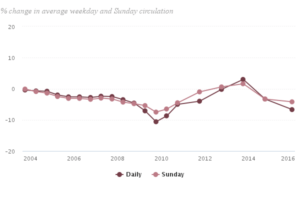
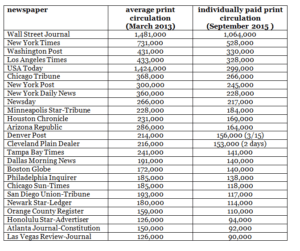

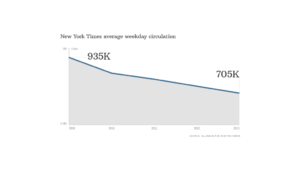
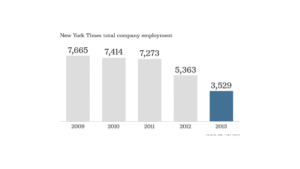
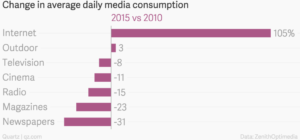
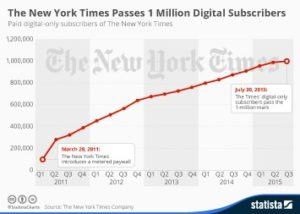
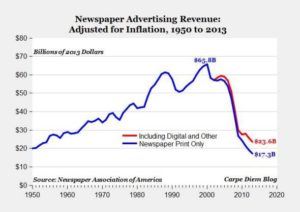


I agree that more responsible media needs to be provided to the public, and agree with the author that there are things NYT could do towards responsible journalism. A bigger issue, however, could be that the public is agnostic of “established” media, and may view what NYT does as somewhat biased/in their own interest. Since technology has democratized information, it may be difficult to back track the trust that established media has lost, which is another root cause of consumption of “unresponsible” media.
I agree with MK that while the NYT can certainly do more to increase its readership by offering increased access online and outreach to immigrant populations, a more fundamental issue is the growing public distrust of established media. Increasingly the media industry has become focused on catering to customer demand i.e., ‘what does our core base of readers/viewers want to hear?’ instead of, ‘what is a balanced (and therefore less entertaining) articulation of an issue?’ The NYT itself published an editorial about its own liberal bias, citing some steps the paper could take to combat it, such as “leaving editorials on the editorial page, banning campaign ads from the home page, or building a better mix of values into the ranks of the newsroom’s urban progressives.” [1] Without these steps, the paper is ignoring half the American readership – it could tinker around the edges to pick up a few more liberal readers through marketing and pricing ploys, or it could focus on more balanced, objective news reporting and op-eds with diverse ideological viewpoints to appeal to a significantly broader base.
[1] http://www.nytimes.com/2016/07/24/public-editor/liz-spayd-the-new-york-times-public-editor.html
Interesting article, NJG.
I would challenge your suggestion that NYT should make the article about ‘core issues’ free to the public, and then try to monetize through digital subscription to the other ‘business and sports’ sections. NYT’s core value proposition is the one that should be monetized because it provides the largest value to users. Most NYT readers are not there to read about sports because NYT is simply not the best/most specialized place to obtain that kind of news! I think this suggestion jeopardizes their up and coming business model, and would lead to a large number of their currently 1.4mn paying subscribers to switch to non-paying. If NYT salesman gave you a free copy of their core articles everyday, would you pay him to buy the sports section? Already, people are finding loopholes to read much more than the 10 free monthly article limit [1]
[1] http://www.lifehack.org/articles/technology/how-to-continue-reading-the-new-york-times-online-for-free.html
As the author points out, the risks associated with disappearing professional journalism were truly highlighted in the latest election. With much of the post-election conversation focusing on ‘fake news’ and how it destroys one foundation of democracy (an informed populace), the NYTimes might have an opportunity to reverse its difficulties in converting users into subscribers. In fact, the backlash against unprofessional news could be one of the biggest opportunities it has had in ages. Recent reports show that news outlets are seeing a surge in subscriptions post election (see: http://adage.com/article/media/york-times-wsj-subscriptions-surge-election/306778/). Perhaps modern society is ready to embrace not only a personal, but civic duty to support the professional press. I think for that reason, the blog author’s plan to offer more free articles could be a mistake in the current environment. Instead, the Times might have a real chance to re-introduce its value proposition to potential subscribers and encourage sign ups.
Hi NJG,
Toward the end of the post, you argue that “the NYT should not only operationalize itself to compete digitally on the same basis as Facebook and Google, but firmly assert its role as the professional and editorial informant to the public.” There’s no question in my mind that the NYT would absolutely love to accomplish these two goals, but they’re increasingly difficult goals to reach, and here’s why:
– Facebook and Google are essentially taking over news organizations’ sway over content distribution. Facebook has recently deployed a tool called “Instant Articles” whereby it stores news articles on its own servers and consequently loads them much faster for FB app users. [1] Instant Articles is shown to improve article readership, but that improvement comes at the expense of outlets’ control over their content distribution. Likewise, Google has recently launched “Accelerated Mobile Pages” (AMP,) an HTML standard for mobile news content.[2] Google algorithms have already been tweaked to penalize articles that don’t abide by the AMP standard, which means news organizations must now choose between adopting the Google-sanctioned HTML standard or ranking lower on Google for mobile searches. In such a scenario, how can the NYT compete on the same basis as Facebook and Google?
– I’d say the NYT already has an impeccable reputation as “the professional and editorial informant” in the eyes of its existing audience. Expanding its audience reach is the actual challenge the paper faces as the media landscape moves toward increasing polarization of editorial stances. President-elect Donald Trump has attacked the NYT’s editorial integrity on Twitter before and since the election. While that reinforces the paper’s editorial independence in the eyes of its long-term readers, it further ostracizes right-wing readers who have long been suspicious of its coverage. How does the NYT wins them over without compromising its values?
Tough questions for the Sulzbergers (and other publishers) to think about!
[1] “Instant Articles,” Facebook, https://instantarticles.fb.com/, accessed November 2016.
[2] “Accelerated Mobile Pages Project”, Google, https://www.ampproject.org/, accessed November 2016.
Great article, and as a rabid Twitter consumer I certainly understand first-hand why alternative digital sources have become a more appealing source of news. One aspect your post didn’t explore – pricing. Most newspapers began exploring a pay-wall model in the last few years. I understand that overall readership is down, but I wonder how much of this is correlated with the pricing schemes these newspapers have decided to pursue. Are there alternative models that could boost revenues and overall readership?
Great post about the NYT!